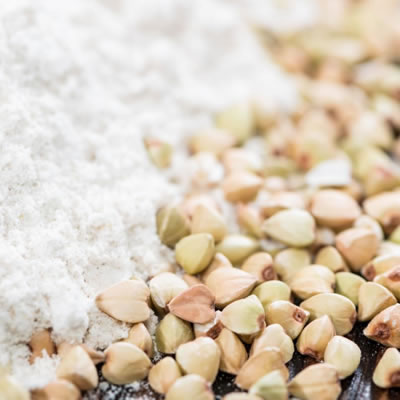Origin
Buckwheat is not a cereal, but a seed that resembles a cereal grain in starch content and composition. Some say it is a “pseudocereal” but it actually belongs to the Polygonaceae flowering plant family just like the rhubarb plant.
It has origin in Western China and came to Europe in the Middle ages. Eventually, it made its way to North America by immigrants.2 The plant does well in areas of high elevation with a short frost-free period. It is an annual plant that has a short growing season (2-4 months) and therefore can function as a second crop. Buckwheat is sustainable because of the short growing season and its tolerance to poor quality, sandy or acidic soil.3
Function
Buckwheat flour adds diversity of texture, taste and appearance to food products. Many people know and love the food it is found in: pancakes, Japanese Soba noodles and Galettes (crepes).
It is best in combination with other flours. For example, cookies made with 40% buckwheat flour rank higher than 100% wheat flour cookies for color, appearance, flavor, texture, and taste. Gluten-free bread with buckwheat and rice flour scores higher than bread with potato starch and rice flour for volume and soft crumb.5
Nutrition
Buckwheat flour is a nutritional powerhouse in comparison to rice and maize, the grains traditionally used in gluten free products. The flour is rich in minerals, antioxidants, and has a well balanced amino acids profile. There is a higher amount of fat in buckwheat flour, but it is primarily unsaturated fat, oleic and linoleic acid.
Comparison of flours6
| Buckwheat | Rice | Maize | Wheat | |
| Protein (g/100g) | 12.2 | 7.3 | 5.5 | 11.5 |
| Total starch (g/100g) | 61.3 | 77.5 | 71.3 | 68.0 |
| Total Fiber (g/100g) | 2.2 | 0.4 | 2.6 | 3.4 |
| Lipids (mg/100g) | 4.2 | 0.9 | 2.5 | 1.8 |
| Polyphenols (mg/100 g) | 465.5 | 14.1 | 97.9 | 13.0 |
| Magnesium (mg/KG) | 1736 | 338 | 315.7 | 234 |
| Iron (mg/100gm) | 28.5 | 6 | 9.1 | 13.4 |
| Zinc (mg/100gm) | 18.8 | 17.8 | 6.6 | 7.6 |
Commercial production
There are two cultivated species of Buckwheat, common and tartary. Common buckwheat is the plant found in food products world-wide, while tartary buckwheat is found in the Himalayan region of the world.7
Buckwheat is grown in every country producing major cereal grains.4 The most common method of processing buckwheat is milling the seed into a flour. From the flour and milled fractions, a variety of food products can be made.
At this time, however, it is not a flour extensively in developed, industrialized nations. In fact, most of Canada’s crop is exported, but there is interest in using this nutritional powerhouse in more foods.
Application
Besides gluten free applications, buckwheat flour enhances the nutritional properties of bread when it partially replaces wheat flour. Since the composition and absorption properties of these flours differs, more water and mixing time is necessary in recipes where buckwheat is used. The threshold of substitution for buckwheat flour in bread is 30%.8
References
- Touzalin, J. “Food: Buckwheat 101”, The Washington Post, 2013, https://www.washingtonpost.com/lifestyle/food/buckwheat-101/2013/01/18/78820e10-5fee-11e2-b05a-605528f6b712_story.html?utm_term=.e080c5375f5e
- Izaydorczyk M, McMillan T, Bazin S, Klette J, Dushnicky L, Dexter J. “Canadian Buckwheat: A unique, useful and under-utilized crop”, Canadian Journal of Plant Science, 2014, 94:509-524,https://doi.org/10.4141/cjps013-0752
- FAO, “Common Buckwheat, Traditional Crops”, 2018. http://www.fao.org/traditional-crops/buckwheat/en/
- Ulfat J, Gani A, Ahmad M, Shah U, Baba W, Masoodi F, Maqsood S, Gani A, Wani I, Wani, S. “Characterization of cookies made from wheat flour blended with buckwheat flour and effect on antioxidant properties.” Journal of Food Science and Technology, 2015, 52.10, pp 6334-6344.
- Alvarez-Jubete L, Auty M, Arendt E, Gallagher E. “Baking properties and microstructure of pseudocereal flours in gluten-free bread formulations.” European Food Research and Technology, 2009, 230.3, pp 437-445.
- Hager, AS, Wolter A, Jacob F, Zannini, E, Arendt E. “Nutritional properties and ultra-structure of commercial gluten free flours from different botanical sources compared to wheat flours.” Journal of Cereal Science, 2012, 56.2, pp 239-247.
- Sytar O, Brestic M, Zivcak M, Tran LS. “The Contribution of Buckwheat Genetic Resources to Health and Dietary Diversity” Current genomics, 2016, vol. 17,3 pp 193-206.
- Ognean M, Ognean CF, Damian D. “Buckwheat, Sustainable Ingredient for Bread Baking: Rheological and Technological Investigation.” Management of Sustainable Development, 2017, 9.2 pp 15-18.

